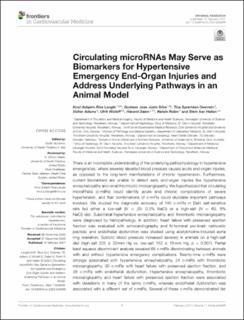| dc.contributor.author | Langlo, Knut Asbjørn Rise | |
| dc.contributor.author | Silva, Gustavo Jose Justo | |
| dc.contributor.author | Overrein, Tina Syvertsen | |
| dc.contributor.author | Adams, Volker | |
| dc.contributor.author | Wisløff, Ulrik | |
| dc.contributor.author | Dalen, Håvard | |
| dc.contributor.author | Rolim, Natale Pinheiro Lage | |
| dc.contributor.author | Hallan, Stein | |
| dc.date.accessioned | 2022-03-25T06:56:05Z | |
| dc.date.available | 2022-03-25T06:56:05Z | |
| dc.date.created | 2022-01-03T15:49:57Z | |
| dc.date.issued | 2021 | |
| dc.identifier.citation | Frontiers in Cardiovascular Medicine. 2021, 7 (431), . | en_US |
| dc.identifier.issn | 2297-055X | |
| dc.identifier.uri | https://hdl.handle.net/11250/2987503 | |
| dc.description.abstract | There is an incomplete understanding of the underlying pathophysiology in hypertensive emergencies, where severely elevated blood pressure causes acute end-organ injuries, as opposed to the long-term manifestations of chronic hypertension. Furthermore, current biomarkers are unable to detect early end-organ injuries like hypertensive encephalopathy and renal thrombotic microangiopathy. We hypothesized that circulating microRNAs (c-miRs) could identify acute and chronic complications of severe hypertension, and that combinations of c-miRs could elucidate important pathways involved. We studied the diagnostic accuracy of 145 c-miRs in Dahl salt-sensitive rats fed either a low-salt (N = 20: 0.3% NaCl) or a high-salt (N = 60: 8% NaCl) diet. Subclinical hypertensive encephalopathy and thrombotic microangiopathy were diagnosed by histopathology. In addition, heart failure with preserved ejection fraction was evaluated with echocardiography and N-terminal pro-brain natriuretic peptide; and endothelial dysfunction was studied using acetylcholine-induced aorta ring relaxation. Systolic blood pressure increased severely in animals on a high-salt diet (high-salt 205 ± 20 mm Hg vs. low-salt 152 ± 18 mm Hg, p < 0.001). Partial least squares discriminant analysis revealed 68 c-miRs discriminating between animals with and without hypertensive emergency complications. Twenty-nine c-miRs were strongly associated with hypertensive encephalopathy, 24 c-miRs with thrombotic microangiopathy, 30 c-miRs with heart failure with preserved ejection fraction, and 28 c-miRs with endothelial dysfunction. Hypertensive encephalopathy, thrombotic microangiopathy and heart failure with preserved ejection fraction were associated with deviations in many of the same c-miRs, whereas endothelial dysfunction was associated with a different set of c-miRs. Several of these c-miRs demonstrated fair to good diagnostic accuracy for a composite outcome of hypertensive encephalopathy, thrombotic microangiopathy and heart failure with preserved ejection fraction in receiver-operating-curve analyses (area-under-curve 0.75–0.88). Target prediction revealed an enrichment of genes related to several pathways relevant for cardiovascular disease (e.g., mucin type O-glycan biosynthesis, MAPK, Wnt, Hippo, and TGF-beta signaling). C-miRs could potentially serve as biomarkers of severe hypertensive end-organ injuries and elucidate important pathways involved. | en_US |
| dc.language.iso | eng | en_US |
| dc.publisher | Frontiers Media | en_US |
| dc.rights | Navngivelse 4.0 Internasjonal | * |
| dc.rights.uri | http://creativecommons.org/licenses/by/4.0/deed.no | * |
| dc.title | Circulating microRNAs May Serve as Biomarkers for Hypertensive Emergency End-Organ Injuries and Address Underlying Pathways in an Animal Model | en_US |
| dc.type | Journal article | en_US |
| dc.type | Peer reviewed | en_US |
| dc.description.version | publishedVersion | en_US |
| dc.source.pagenumber | 13 | en_US |
| dc.source.volume | 7 | en_US |
| dc.source.journal | Frontiers in Cardiovascular Medicine | en_US |
| dc.source.issue | 431 | en_US |
| dc.identifier.doi | 10.3389/fcvm.2020.626699 | |
| dc.identifier.cristin | 1973886 | |
| cristin.ispublished | true | |
| cristin.fulltext | original | |
| cristin.qualitycode | 1 | |

